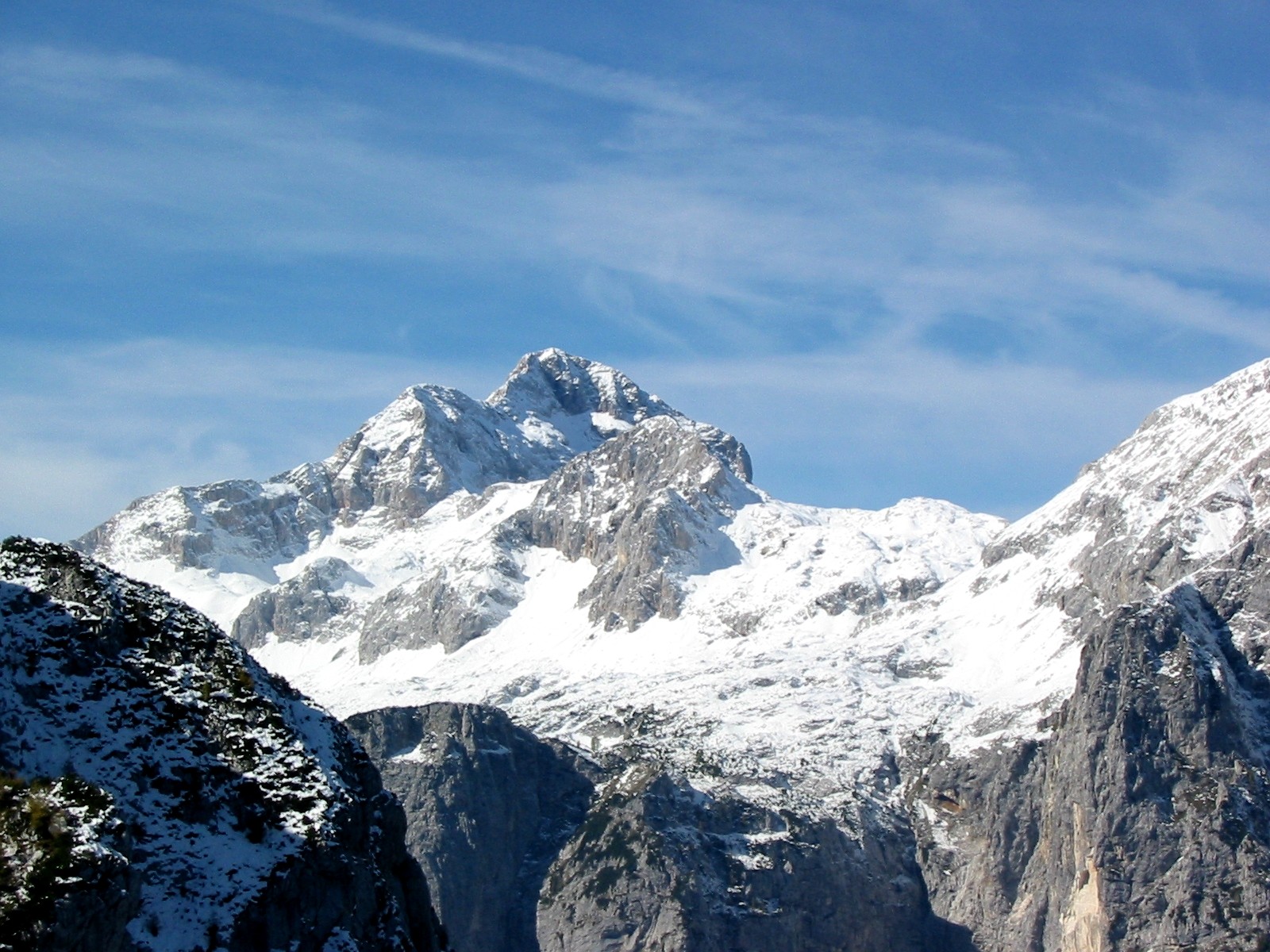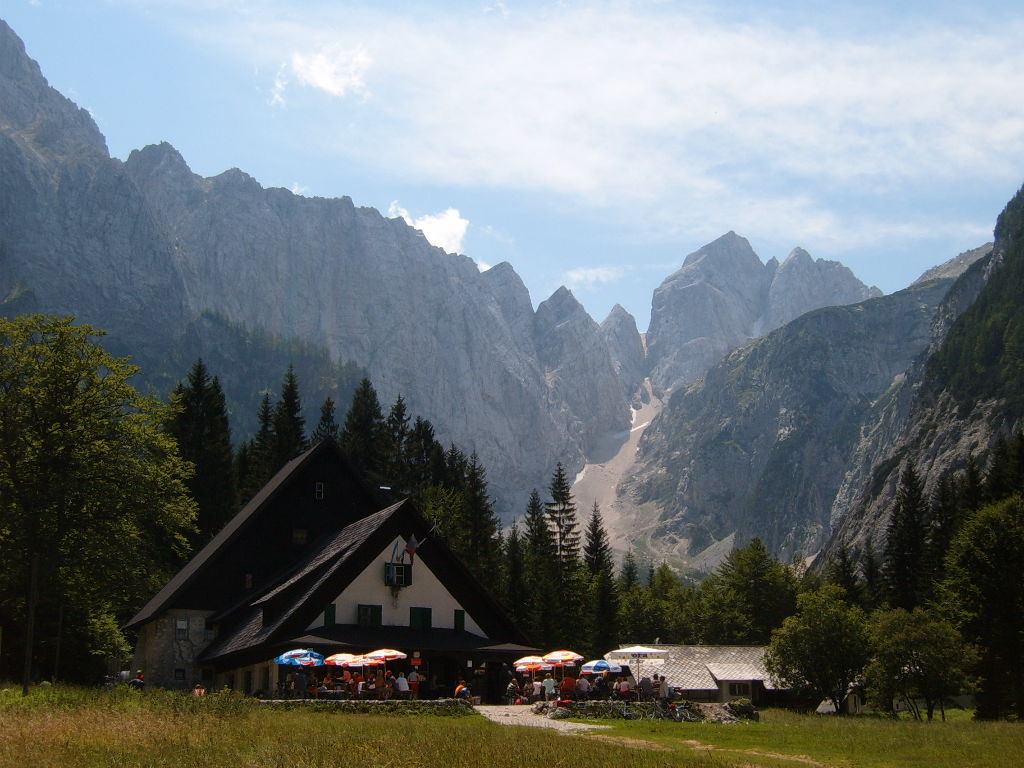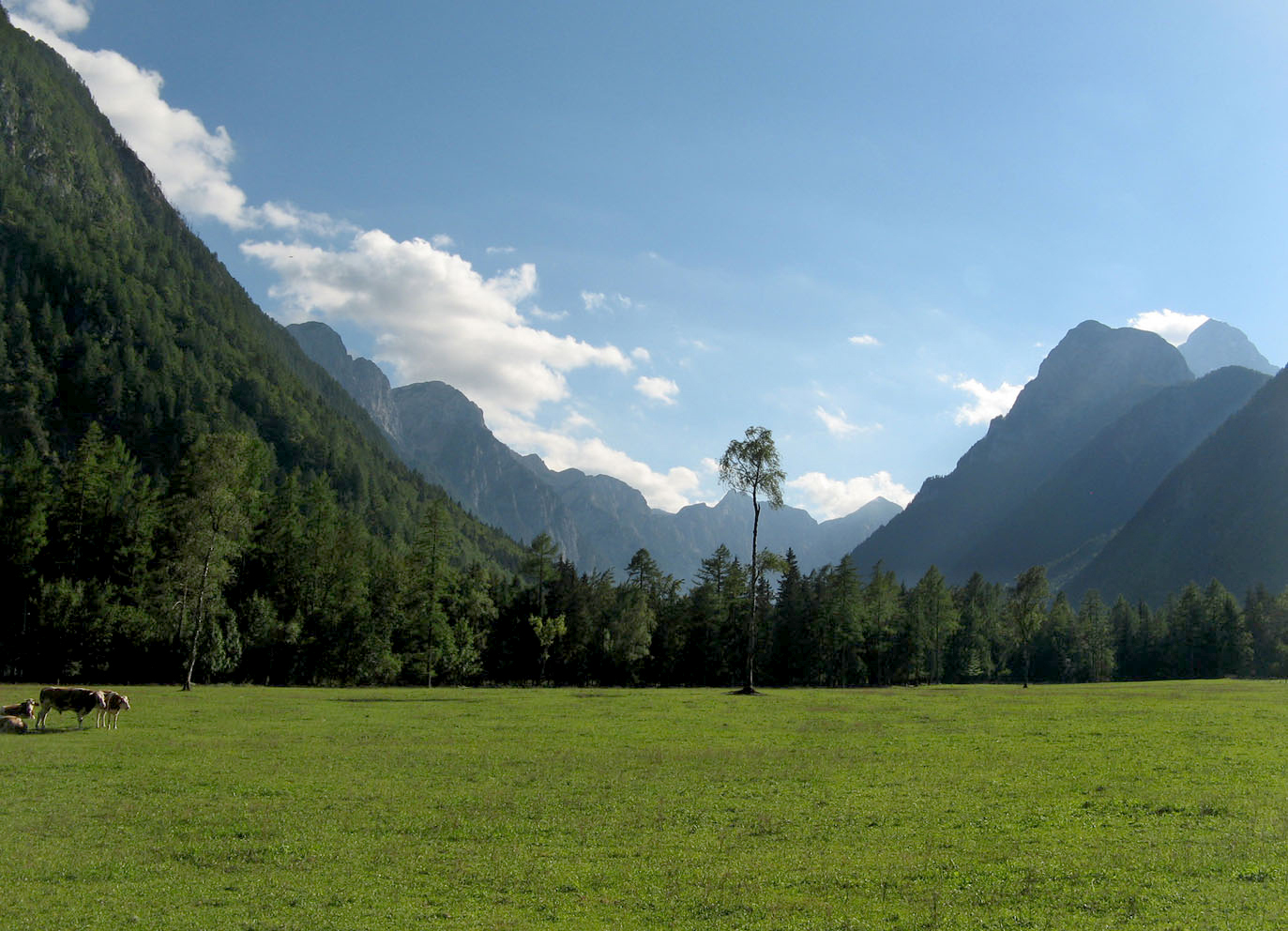|
Kot Valley
Kot is an alpine valley in the Julian Alps in the Upper Carniola region, northwestern Slovenia. It is included in Triglav National Park in its entirety. Kot is one of three glacial alpine valleys near Mojstrana, the others being Vrata and Krma. It is the starting point for many routes through the Triglav National Park area and one of the easier and faster routes up Mount Triglav. It leads into the Radovna Valley The Radovna Valley ( sl, Radovna, ) is an alpine valley in the Julian Alps in northwestern Slovenia, traditionally part of Upper Carniola. It is included in Triglav National Park in its entirety. Geography The Radovna Valley is surrounded by the .... Valleys in Upper Carniola Valleys of the Julian Alps Municipality of Kranjska Gora Triglav National Park {{KranjskaGora-geo-stub ... [...More Info...] [...Related Items...] OR: [Wikipedia] [Google] [Baidu] |
Julian Alps
The Julian Alps ( sl, Julijske Alpe, it, Alpi Giulie, , ) are a mountain range of the Southern Limestone Alps that stretch from northeastern Italy to Slovenia, where they rise to 2,864 m at Mount Triglav, the highest peak in Slovenia. A large part of the Julian Alps is included in Triglav National Park. The second highest peak of the range, the 2,755 m high Jôf di Montasio, lies in Italy. The Julian Alps cover an estimated 4,400 km2 (of which 1,542 km2 lies in Italy). They are located between the Sava Valley and Canale Valley. They are divided into the Eastern and Western Julian Alps. Name The Julian Alps were known in antiquity as ''Alpe Iulia'', and also attested as ''Alpes Juliana'' AD 670, ''Alpis Julia'' 734, and ''Alpes Iulias'' in 1090. Like the municipium of ''Forum Julii'' (now Cividale del Friuli) at the foot of the mountains, the range was named after Julius Caesar of the Julian clan, perhaps due to a road built by Julius Caesar and completed by Aug ... [...More Info...] [...Related Items...] OR: [Wikipedia] [Google] [Baidu] |
Upper Carniola
Upper Carniola ( sl, Gorenjska; it, Alta Carniola; german: Oberkrain) is a traditional region of Slovenia, the northern mountainous part of the larger Carniola region. The centre of the region is Kranj, while other urban centers include Jesenice, Tržič, Škofja Loka, Kamnik, and Domžale. It has around 300,000 inhabitants or 14% of the population of Slovenia. Historical background Its origins as a separate political entity can be traced back to the 17th century, when the Habsburg duchy of Carniola was divided into three administrative districts. This division was thoroughly described by the scholar Johann Weikhard von Valvasor in his 1689 work ''The Glory of the Duchy of Carniola''. The districts were known in German as ''Kreise'' (''kresija'' in old Slovene). They were: ''Upper Carniola'' with its centre in Ljubljana, comprising the northern areas of the duchy; ''Lower Carniola'', comprising the east and south-east, with its centre in Novo Mesto; and ''Inner Carniola'' ... [...More Info...] [...Related Items...] OR: [Wikipedia] [Google] [Baidu] |
Slovenia
Slovenia ( ; sl, Slovenija ), officially the Republic of Slovenia (Slovene: , abbr.: ''RS''), is a country in Central Europe. It is bordered by Italy to the west, Austria to the north, Hungary to the northeast, Croatia to the southeast, and the Adriatic Sea to the southwest. Slovenia is mostly mountainous and forested, covers , and has a population of 2.1 million (2,108,708 people). Slovenes constitute over 80% of the country's population. Slovene, a South Slavic language, is the official language. Slovenia has a predominantly temperate continental climate, with the exception of the Slovene Littoral and the Julian Alps. A sub-mediterranean climate reaches to the northern extensions of the Dinaric Alps that traverse the country in a northwest–southeast direction. The Julian Alps in the northwest have an alpine climate. Toward the northeastern Pannonian Basin, a continental climate is more pronounced. Ljubljana, the capital and largest city of Slovenia, is geogr ... [...More Info...] [...Related Items...] OR: [Wikipedia] [Google] [Baidu] |
Triglav National Park
Triglav National Park (TNP) ( sl, Triglavski narodni park) is the only national park in Slovenia. It was established in its modern form in 1981 and is located in the northwestern part of the country, respectively the southeastern part of the Alpine massif. Mount Triglav, the highest peak of the Julian Alps, stands almost in the middle of the national park. From it the valleys spread out radially, supplying water to two large river systems with their sources in the Julian Alps: the Soča and the Sava, flowing to the Adriatic and Black Sea, respectively. History The proposal for the protection of the Triglav Lakes Valley area was first put forward by the seismologist Albin Belar in 1906 or 1908. However, the proposal was not accepted, as there was no legal base for it and the then valid laws prohibited any restriction of pasture. The strategic basis for the protection of the area, titled ''The Memorandum'' (), and which explicitly mentioned the proposal of Belar, was submitted to ... [...More Info...] [...Related Items...] OR: [Wikipedia] [Google] [Baidu] |
Mojstrana
Mojstrana (; german: Meistern) is a village in the Municipality of Kranjska Gora in the Upper Carniola region of Slovenia. Geography Mojstrana is located in the Upper Sava Valley at the point where Bistrica Creek joins the Sava River below the main road from Jesenice to Kranjska Gora at an elevation of 641 m. The glacial Vrata Valley leads from Mojstrana towards the southwest past Peričnik Falls to the north face of Mount Triglav. The road to three other valleys— Radovna, Krma, and Kot—also begins in Mojstrana. Name Mojstrana was first attested in 1763–87 as ''Moistrana''. The suffix ''-ana'' indicates that the name is of Romance or pre-Romance origin. The root ''*mojstr-'' is believed to be related to Friulian ''majostre'' 'strawberry, blueberry' (cf. the oronym ''Mojstrovka'' from this root), thus referring to an area rich in strawberries or blueberries. History The development of the settlement is connected to ironworks and iron ore in the area as well as a cemen ... [...More Info...] [...Related Items...] OR: [Wikipedia] [Google] [Baidu] |
Vrata (valley)
Vrata is a Sanskrit word that means "vow, resolve, devotion", and refers to pious observances such as fasting and pilgrimage ( Tirtha) found in Indian religions such as Jainism and Hinduism. It is typically accompanied with prayers seeking health and happiness for their loved ones. Etymology Vrata (Sanskrit: व्रत) means "vow, resolve, devotion",Monier Monier-Williams (1899), Sanskrit-English Dictionary, Oxford University Press, page 1042, Article on ''Vrata'' and refers to the practice of austerity, particularly in matters related to foods and drinks by people in Hindu and Jaina culture, as part of a pious observance or prayers seeking health, fertility, long life or happiness for her loved ones. Derived from the root ''‘vr’'' ("will, rule, restrain, conduct, choose, select"), the word is found over 200 times in the Rigveda. It is also found in other Vedic literature including the Upanishads, but the context suggests that the meaning of the word in the Vedic era wa ... [...More Info...] [...Related Items...] OR: [Wikipedia] [Google] [Baidu] |
Krma (valley)
Krma is an alpine valley in the Julian Alps in the Upper Carniola region of northwestern Slovenia. The entire valley lies in Triglav National Park. Name The name ''Krma'' is of uncertain origin, possibly derived from a substrate root such as *''karma'' or *''garma'', which may be preserved in Istrian Romance ''karma'' 'rock crevice'; it is less likely to be related to Albanian ''karmë'' 'rocky hill'. It cannot be excluded that the name may also be connected with the Slovene common noun ''krma'' 'fodder' because of historical pasturing activity in the valley. Geography Krma is the longest and easternmost of the glacial valleys near Mojstrana. It is the starting point for many routes through Triglav National Park. The lower northern end of the Krma Valley intersects with the upper western end of the Radovna Valley. Approximately two-thirds of the way up the valley is the Kovinar alpine lodge (elevation: ) with 15 berths, a popular stopping point for hikers. This lodge was o ... [...More Info...] [...Related Items...] OR: [Wikipedia] [Google] [Baidu] |
Triglav
Triglav (; german: Terglau; it, Tricorno), with an elevation of , is the highest mountain in Slovenia and the highest peak of the Julian Alps. The mountain is the pre-eminent symbol of the Slovene nation. It is the centrepiece of Triglav National Park, Slovenia's only national park. Triglav was also the highest peak in Yugoslavia before Slovenia's independence in 1991. Name Various names have been used for the mountain through history. An old map from 1567 named it ''Ocra mons'', whereas Johann Weikhard von Valvasor named it ''Krma'' in the second half of the 17th century. According to the German mountaineer and professor Adolf Gstirner, the name ''Triglav'' first appeared in written sources as ''Terglau'' in 1452, but the original source has been lost. The next known occurrence of ''Terglau'' is cited by Gstirner and is from a court description of the border in 1573. Early forms of the name ''Triglav'' also include ''Terglau'' in 1612, ''Terglou'' in 1664 and ''Terklou'' arou ... [...More Info...] [...Related Items...] OR: [Wikipedia] [Google] [Baidu] |
Radovna Valley
The Radovna Valley ( sl, Radovna, ) is an alpine valley in the Julian Alps in northwestern Slovenia, traditionally part of Upper Carniola. It is included in Triglav National Park in its entirety. Geography The Radovna Valley is surrounded by the northern extensions of the Pokljuka Plateau, the foothills of the Triglav range, and the highest peak of the Mežakla Plateau, Jerebikovec (). It is connected by a road via the Kosmač Pass to the north with nearby Mojstrana and a road leads down the valley towards Bled. The Radovna River, created by smaller tributaries from the glacial valleys of the Krma and Kot valleys, flows through it. From the valley, the Radovna continues its flow into the Vintgar Gorge, a deep and picturesque canyon, and finally joins the Sava Dolinka near Moste. Extensive pastures in the valley are used for cattle. There are also a number of private holiday homes scattered throughout the valley. The largest settlement in the valley is Zgornja Radovna ... [...More Info...] [...Related Items...] OR: [Wikipedia] [Google] [Baidu] |
Valleys In Upper Carniola
A valley is an elongated low area often running between Hill, hills or Mountain, mountains, which will typically contain a river or stream running from one end to the other. Most valleys are formed by erosion of the land surface by rivers or streams over a very long period. Some valleys are formed through erosion by glacier, glacial ice. These glaciers may remain present in valleys in high mountains or polar areas. At lower latitudes and altitudes, these glaciation, glacially formed valleys may have been created or enlarged during ice ages but now are ice-free and occupied by streams or rivers. In desert areas, valleys may be entirely dry or carry a watercourse only rarely. In karst, areas of limestone bedrock, dry valleys may also result from drainage now taking place cave, underground rather than at the surface. Rift valleys arise principally from tectonics, earth movements, rather than erosion. Many different types of valleys are described by geographers, using terms th ... [...More Info...] [...Related Items...] OR: [Wikipedia] [Google] [Baidu] |
Valleys Of The Julian Alps
A valley is an elongated low area often running between Hill, hills or Mountain, mountains, which will typically contain a river or stream running from one end to the other. Most valleys are formed by erosion of the land surface by rivers or streams over a very long period. Some valleys are formed through erosion by glacier, glacial ice. These glaciers may remain present in valleys in high mountains or polar areas. At lower latitudes and altitudes, these glaciation, glacially formed valleys may have been created or enlarged during ice ages but now are ice-free and occupied by streams or rivers. In desert areas, valleys may be entirely dry or carry a watercourse only rarely. In karst, areas of limestone bedrock, dry valleys may also result from drainage now taking place cave, underground rather than at the surface. Rift valleys arise principally from tectonics, earth movements, rather than erosion. Many different types of valleys are described by geographers, using terms th ... [...More Info...] [...Related Items...] OR: [Wikipedia] [Google] [Baidu] |
Municipality Of Kranjska Gora
The Municipality of Kranjska Gora (; sl, Občina Kranjska Gora) is a municipality on the Sava Dolinka River in the Upper Carniola region of northwest Slovenia, close to the Austrian and Italian borders. The seat of the municipality is the town of Kranjska Gora. Geography The municipality is located in the Upper Sava Valley, a typical Alpine valley. Located at the far northwest of Slovenia where the borders of Slovenia, Austria, and Italy meet, the valley is embraced on the north and south by the peaks of the Karawanks and the Julian Alps. In the east its border runs just below the town of Jesenice, where the valley opens up towards the Radovljica Valley, extending in the west along the watershed between the Sava and Slizza rivers, just west of Rateče. In the north the Wurzenpass at Podkoren leads to Arnoldstein in Carinthia, in the south the Vršič Pass connects it with Trenta in the Slovenian Littoral region. The Upper Sava Valley has an Alpine climate with ... [...More Info...] [...Related Items...] OR: [Wikipedia] [Google] [Baidu] |





